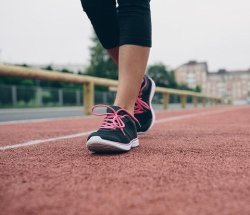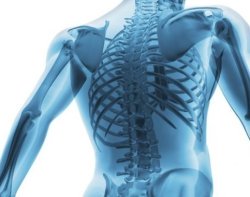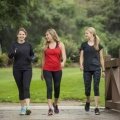Walking for Exercise


Walking for exercise is a great way to get active and help you lose weight and stay in shape. It's a low impact exercise that gives you both cardio and toning results.
This is a great workout for all fitness levels, but is especially good for someone who is new to exercise.
It can be done by yourself at your own pace or with a partner.
And the beauty of it is that there is no membership to purchase for this type of workout. Simply put on your walking shoes and head out the door.
You can walk at the local school track, a park, your neighborhood, at the mall or even at home on your treadmill. You can move at a brisk pace to get the heart rate going or a slower pace for a more relaxing activity by just getting outside to enjoy the weather. Walking for your workout gives you many benefits beyond just helping you to lose weight.
Walking Routine
Featured Articles
If you want to introduce walking for exercise into your weekly routine, then you want to be prepared. There is very little equipment required for this type of workout. In fact, the one and only thing you need is a good pair of walking shoes. By investing in the proper shoes you can help prevent injury as well as increase the effectiveness of your routine.
While it's not required to have specific clothes for this, you want to make sure what you are wearing is comfortable and loose-fitting so your clothes move easily as you walk. You also want socks that fit properly at the toe and the heel. Also, it possible, use sweat-wicking fabric to minimize blisters.
Now that you have the right apparel, it's time to get the walking for exercise routine started...right? Well not quite yet.
As with any exercise, you want to warm up your muscles and slowly raise your heart rate before getting into the heavy, sweating portion of the workout. So start out by walking at a modest pace for about four to five minutes. This will get your blood flowing and warm up your muscles.
Once you have warmed up, take a bit to stretch those muscles you will be using while walking for exercise. Stretch your arms, shoulders, back and even your head. Then move to stretching the lower body, especially those muscles in your legs.
Now it's time to pick up the pace and walk more briskly for 20 to 30 minutes to get a good workout. Of course if you are just starting out, pick a time and pace that is best for you. As you become accustomed to that, increase the pace and the time.
If you are unsure if you are walking too fast, use the “talk test”. If you find that you can not carry on a conversation without losing your breath you should walk at a slower pace. If however you can sing a song, then go a little faster.
After you have walked at the brisker pace for your designated time, then slow it down and walk for a few more minutes to cool down. Cooling down allows you to bring your breathing, body temperature and heart rate back to normal slowly. It also gives the body time redistribute blood properly to the heart.
Benefits of Walking for Exercise
There are many benefits of walking for exercise including shedding some extra pounds and relieve some tension. But there are many more health benefits.

Stronger Heart
Walking strengthens the heart. Studies show that the mortality rate in retired men who walked less than a mile per day were almost double that of men who walked more than two miles per day
Similar for women, one study showed that walking for exercise three or more hours per week reduced their risk of a heart attack by 35% compared to women who did not walk.
Strong bones, strong body
Around age 30, our muscle strength and bone mineral density naturally begin to diminish. If we do nothing, these changes in our body increase our risk of falls, fractures and conditions like osteoporosis.

However, studies show that regular exercise, like walking, has been shown to slow or stop muscle and bone loss. Women who walked about one mile each day showed higher whole-body bone density than women who walked less. Walking can also help slow the rate of bone loss from the legs.
Most of us tend to walk at the same pace for the same amount of time. And while this is goods to slow down bone density loss, it's not enough to build new muscle and bone cells. In order to do that, you need to switch up your walk to put more load on your body.
You can do this by picking up the pace, making your walk more brisk and even try jogging for part of it. You can also add more resistance by adding some hills and inclines during your walk. If you use a treadmill, then increase the incline. If walking outside, try adding a path that includes some stairs.
Brain Power
You can improve your cognitive functions by simply walking for exercise at least one and half hours per week. So if you want to out-do your co-workers and get that promotion, go for a walk and exercise your body as well as your mind.
When walking for exercise, you are taking deeper breaths. This oxygenates the blood and with the heart pumping faster, the circulation increases and more oxygen get to the brain.
However, it's not just the heart beating faster that gives us improved brain function. A research study, done at New Mexico Highlands University, looked at 12 healthy young adults. They measured the impact of blood flowing upward as they walked. Researchers found that the foot's impact on the ground while walking sends pressure waves through the arteries. This wave increases the supply of blood to the brain.
Ease Depression symptoms
Walking for exercise, or any regular workout routine, can help ease symptoms of depression as well. Taking a 30 minute walk three to five times a week helps minimize depression symptoms.
When you workout, your body releases "feel-good" endorphins which can enhance your sense of well being. Walking can also help take your mind off your worries.
In addition, exercise has many psychological and emotional benefits like increased confidence and more social interaction. So walking really is good for the heart, body, mind and soul.
Other Benefits
Additionally, walking can reduce the risks of certain diseases like type 2 diabetes and certain cancers like breast and colon cancer. And of course, walking promotes fitness. So get all the benefits of walking as exercise so you can lose weight, have a healthier heart, body, mind and soul.
Power Walking Techniques
Did you know that walking is actually an Olympic sport? Neither did I until I started researching the benefits of walking. The Olympic sport of walking, known as racewalking or speed walking, actually has specific techniques and rules that must be followed.
What we do typically is called power walking. Of course there is the leisure walk that you may do with your kids or while taking a stroll through the park. Even the leisure walk is good for stress relief and staying fit.

But to really go for the calorie burn and weight loss, you will want to do a power walk. You don't have to be an Olympian to get all the benefits of walking. Just use these power walking techniques to kick it up a notch.
Arms
Swing your arms as you walk. While keeping your arms at a 90 degree angle, swing them back and forth. Be sure your hands are loose and relaxed. No need to tighten them into a fist. Keep your arms close to the body and don’t cross them over your chest.
Head
Walk with your head up and make sure your back is straight. Leaning forward or back will slow you down, so keep a straight back. Keep your head up but relaxed and relax your shoulders as well.
Toes
Point your toes straight ahead. Don’t walk flat footed. Walk heal to toe for the most benefit of your power walk. Make contact to the ground with your heal and push off with your toes.
Stride
Walk with a long, easy stride that doesn't strain you. Don’t overstride as this may cause fatigue and you won’t be able to walk as long. So don’t over lengthen your stride. Keep it at a stride that works for you and try increasing the speed by moving your arms faster. Your legs will follow suit
Hips
Rotate your hips as you walk. This technique is why some people don’t like to power walk as it looks a bit funny. But by swinging your hips it will help increase the speed.
Using a treadmill to power walk is a great way to get the hang of it. This way, you can fine tune your power walking techniques from the privacy of your own home before hitting the sidewalks in your neighborhood.
In addition to just walking for exercise, add some spurts of sprinting with these interval training routines.
Additional Articles
Benefits of Warming up and Cooling Down
Make sure you warm up and cool down before and after your walk. These two important steps to any workout has many benefits to you and
your body.
Best Fat Burning Exercises
Are you getting the best fat burning benefits from your workouts? Read
this article to find out what's the best way to burn fat through
exercising.
Eating Before Exercise
Find out what and when to eat before you head out the door for you do
your walking for exercise.



